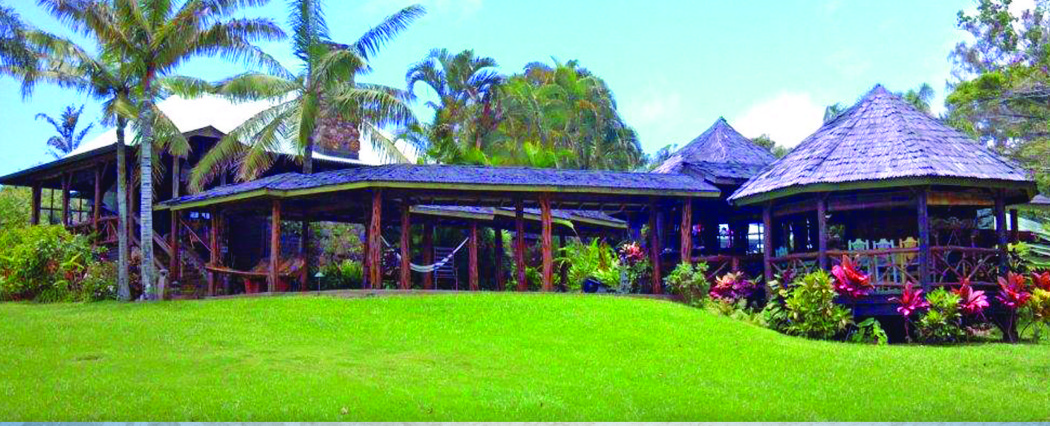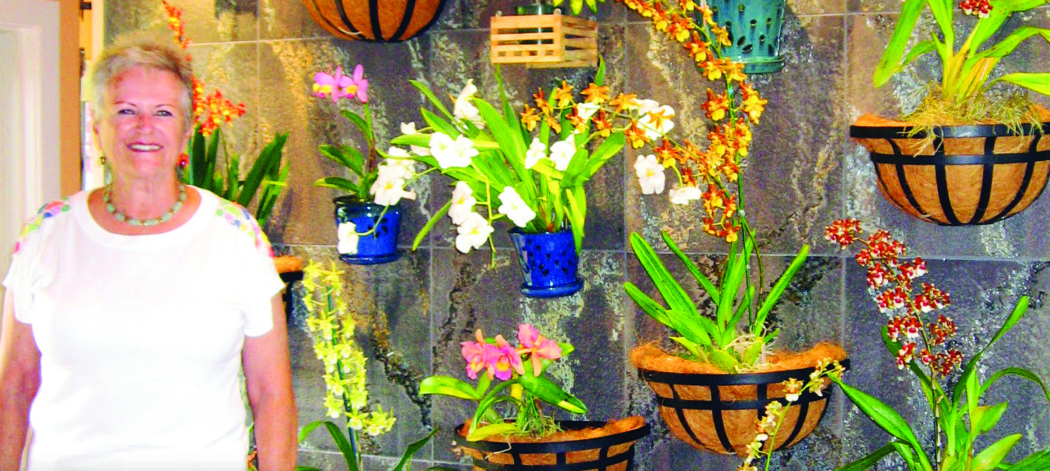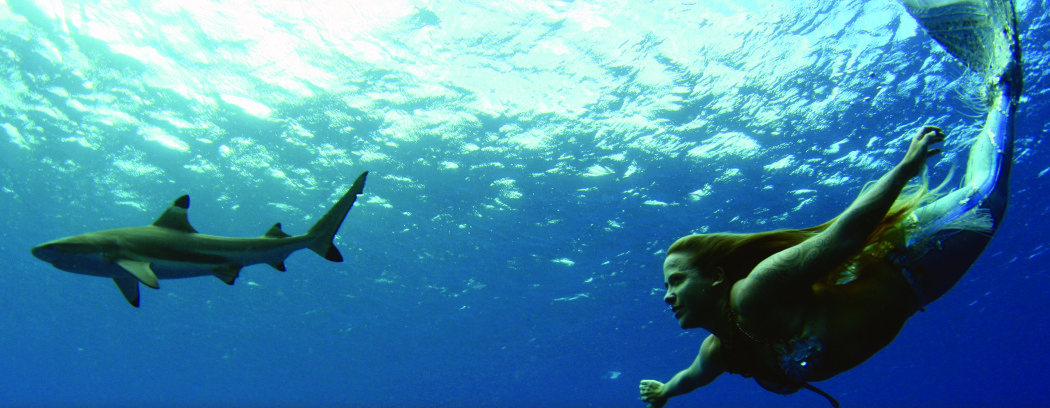
A Mission of Enduring Gratitude: One Boy’s Life Opened a Door for Community Caring
 By Karen Valentine
By Karen Valentine
A beam of light filters through the thickly compacted branches towering overhead, highlighting the myriad hues of green: from light and delicate fern shades to deep and mysterious jungle tones. “My cathedral,” 25-year-old Daniel “Danny” Sayre calls the beautiful valley along which his favorite trail traverses the back of majestic Pololū Valley in North Kohala; he can look up and see the waterfalls and look down to see where they splash into the stream 500 feet below. However, he has to climb out onto a tree limb to get a full view of the waterfalls. It’s important to do this today as this is his last day in Hawai‘i as he prepares to return to the mainland and resume his college commitment, after having taken a three-year break. He wants a photo of this special place. He’s already taken snapshots of friends visited on a farewell tour around the island. An experienced hiker and avid surfer, Danny knows he wants to collect memories of Hawai‘i, this island and his favorite places, to take with him and last forever in his heart.
In the distance, the sound of a helicopter rotor approaches—whup, whup, whup. On the trail overlooking Danny’s “cathedral,” stand Dr. Frank Sayre and Laura Mallery-Sayre. It’s two days later, and Danny hasn’t returned from his hike. Calls to his apartment by his father have gone unanswered, and the worried parents finally decided to call the police to report him missing. Not too long afterward, the police called to say a hiker had found his backpack and shoes next to a tree limb with its bark scraped off and the ground below it disturbed, as if someone had fallen there. The Hawai‘i County Fire Department was called in for a search and rescue mission. A county helicopter had made a first pass over the valley, returning before nightfall without spotting the missing hiker. At first daybreak the next day, Frank and Laura took their own backpacks and headed up to the trail from their home at Kaloko, Kona.
Calling and calling, “Danny… Danny… if you’re down there, can you hear us? They’re going to get you out. Just hang in there….”
The 4,000 square mile land mass called the island of Hawai‘i is blanketed with scenes of awesome natural beauty. They make your spirit soar in wonder at the magnificence. They are magnets for hikers and nature lovers; and, they are death-defyingly dangerous for rescue workers who make it their life’s work to get people out of the traps into which they’ve led themselves. Over snow-covered mountain peaks in blizzards, into dense rainforests slippery with vertical slopes and shear drops, and out into dangerous surf conditions and rip tides along the 400 miles of accessible shoreline they venture.
Here on the Pololū Valley/Kapaloa Falls Trail on August 28, 1997, the task is a daunting one. Above them lies Kapaloa Falls and below is another waterfall, making access by foot impossible. The cliffs are a shear, vertical drop to a stream flowing between the two falls.
“There’s no way to hike in,” said Laura Mallery-Sayre, who, with her husband, Frank, was observing the drama while living it, with hearts pounding and minds disbelieving. “The walls of the valley are too steep to go down without rappelling, and they didn’t have the ropes to rappel down that far. They had to keep attempting with the helicopter and it kept coming and they kept trying.” And hoping. “One of the firefighters kind of took us under his wing and became our counselor on the spot. FRS (Fire Rescue Specialist) Lana Rowe really kept us together. He kept informing us of what was happening and got us to talk about Danny. ‘Tell us about Danny,’ he would say. ‘What’s Danny like?’ He kept us focused.”
Whup, whup, whup…. the helicopter makes its first pass, and another.
“They’d fly away and then come back and then fly away,” said Dr. Frank Sayre, owner of a Kailua-Kona dental practice. “They did this for the better part of the day, a total of 10 hours. Then they basically called the whole thing off.”
Into the narrow valley, darkness comes early. The shadows creep in and visibility dims, as do the hopes of those standing and watching helplessly.
“Captain Russel Miyao came to us and said, ‘Dr. and Mrs. Sayre, we really think you should leave,’ ” said Laura. “ ‘The mission’s being called off at this point. We’ll come back tomorrow.’ And I said, ‘Can you assure me that he’s dead?’ and he said, ‘No, I can’t.’ ‘I’m so sorry, but we’re not leaving.’ ”
That was when every member of the Hawai‘i Fire Department (HFD) rescue team, dispatched to the scene from the Waiakea station at Hilo, then volunteered to stay—on their own time.
Another helicopter pilot had been called in, David Okita of Volcano Helicopter Company.
“This guy was kind of a ‘helicopter god,’” said Dr. Sayre. “Everybody just snapped to. You just knew something was going to happen. He made one pass and then he picked up two guys from the staging area in the pasture. They were dangling 1,000 feet up in the air. They didn’t have a cable long enough for the helicopter to stay up high and let them down. He had to descend between the valley walls and drop them off. We were actually looking down on the top of the helicopter, and the valley was so tight that the rotor was knocking leaves off the branches of trees on both sides.”
Laura said: “We knew that a similar rescue attempt on O‘ahu just the year before had ended in all the rescue workers being killed. “ This was a very risky mission, but they were committed.
All the while, Fire Rescue Specialists Clarence Young and James Kuniyoshi were dangling from the cable over the valley. With rotors precisely placed within dangerous proximity to either side of the valley and shadows descending, David Okita expertly lowered them down to the stream at the bottom. On his first pass, the pilot had spotted Danny down there. Any mistake could mean instant tragedy for all. The two-man rescue team landed and quickly assessed the situation. Danny was dead; he had broken his neck in the fall. Clarence Young radioed up to Lana Rowe, who passed the news on to Frank and Laura: “Dr. and Mrs. Sayre, your son is gone.”
Dr. Frank Sayre is an accomplished dental surgeon, specializing in TMJ (temporomandibular joint disorder), cosmetic dentistry, and according to his wife and dental hygienist Laura, one of the leading dental implant specialists in the state. He is a gentle, compassionate man with a friendly personality, whose face and smile reflect an open heart. Laura Mallery-Sayre is an international speaker and educator in the science and practice of dental hygiene, as well as a practitioner alongside her husband. Her personality is straightforward, articulate and magnetic. On the day their son died, they were simply a pair of devastated parents.
“You can’t make the pain go away,” says Dr. Sayre, “nor do you want to.”
“We tried to say thank you [to the rescue crew], but we were destroyed at that point,” said Laura.
Soldiers who have fought side by side in wars know the tight bonds that develop between humans who have traveled life’s darkest moments together. At that moment, Frank and Laura Sayre fell in love with the HFD Search and Rescue Department—every one of them. Their hurt was so deep and their gratitude so profound that they had to put the emotion somewhere.
On the drive home from Kohala Hospital, where they had gone to identify Danny’s body, a huge, double rainbow appeared alongside them. They pulled the car over, got out, hugged each other and just cried.
“That rainbow followed us all the way home,” said Laura. They felt Danny with them. On that same drive home, Frank and Laura were struck with the idea of creating some kind of endowment fund in honor of Danny. “It came to us both at the same time. We knew we wanted to do something, and we know it wasn’t our thought. It was from Dan. We’re very clear on that. It happened instantly and we both started talking about it at the same time,” Laura said.
During the rescue/recovery operation, both the Sayres were struck by the way the HFD personnel had performed under not only dangerous conditions, but also with equipment that was insufficient for the terrain and challenges that faced them.
“We knew that, at the risk of their own lives, they went beyond the call of duty to get closure for us.”
“They were our heroes,” said Frank. “We wanted to find a way for them to be recognized by the community, to give them an award or something. We found there was nothing like that. Then we started digging a little deeper into what they didn’t have and we found out that the search and rescue equipment is somewhere down the line in budgetary allocations.”
Laura said, “We learned that they were going to call O‘ahu to bring in ropes long enough [to reach the bottom of the valley] for us. We thought, ‘The entire island is covered with these valleys, they have been here for how many years, and the Fire Department didn’t have ropes long enough to get to the bottom of them? How much can a rope cost? Well, we found out they were $1,500 a set. That was the very first thing we bought: one set for each side of the island.”
The Sayres first formed an endowment fund within the Hawai‘i Community Foundation and later, in 2008, established their own 501c3 foundation, the Daniel R. Sayre Memorial Foundation, which serves as a “community calabash” for others to contribute to helping those who help us all. Its mission is not only to upgrade the search and rescue equipment, but to recognize the tireless efforts of those they call “our heroes.” At an annual banquet fundraiser, they recognize some of those whose efforts have stood out during the year.
The mission of the Hawai‘i County Fire Department states: “The Hawai‘i County Fire Department has the responsibility of providing the highest level of service, above and beyond what people expect, in life preservation, incident stabilization, and property conservation.”
In July of this year, rescue crews searched day and night for two teenagers who were swept out to sea in a kayaking accident. The thermal imaging equipment donated by the Sayre Foundation allowed them to operate after dark; the crews worked tirelessly and beyond the official rescue period. Fire Chief Darren Rosario explained, “When tragedy hits someone else, you know that it could also hit closer to home, and you would want someone to do the same thing for you. In 2002, one of our rescue workers fell down a lava tube and was critically injured. At the end of the day, we want to know we have done our best.”
Brent Matsuda, former Fire Equipment Operator at Waiakea Rescue Company 2, said, “When I first started working at a rescue station in the Hawai‘i Fire Department, I used to hope for rescues to gain experience. Now I realize that when we are on a rescue mission, someone is not having a good day. The public sometimes perceives that firefighters have a lot of idle time, but they do not always see or hear about many incidents that happen. During my time in the HFD, I have seen so much tragedy that it feels really good to rescue someone who needs our help. Even through the length and frustrations of this rescue [describing a grueling rescue of hunters in the Ka‘ū Forest Reserve], no one grumbled, no one gave up, we all knew what had to be done. This rescue was done with integrity, pride, commitment to service, teamwork, with safety always in mind. I have always felt that it is a privilege to help the people who need our services.” In 2002, Brent Masuda himself was rescued from a fall into a lava tube, suffering critical injuries. The ropes used to rescue him were the ones donated by the Sayre Foundation.
“We’ve been able to honor the men and women who have gone above and beyond the call of duty in helping to save lives here,” says Laura, “and that makes us feel good, too. They don’t ask for recognition. In fact, some of them are just downright embarrassed to be honored just for doing their job. I have asked them to be humble recipients, even though some of them don’t want to be there. But I’ve asked them to come, because our community needs to be able to say thank you.”
She tells of several people who have come to the recognition events just to say thank you. One was Neil Swartz, who was saved from drowning by lifeguard Ricky Alvarez. He came to a Sayre Foundation “gifting” event early this year, which was presenting water rescue equipment to the county. He wanted to thank Alvarez and also made a donation. “It was a love-in,” says Laura.
“Frank and I started this foundation, but it’s truly not our foundation, it’s the community’s. We’ve taken this little teeny concept and the community made it bigger and very, very successful. Without the support of the community, this would have just fizzled. We’re making bigger strides each year. We are making a difference. We have so much gratitude to everyone who’s been supportive.”
Another couple who has channeled their grief into giving back is California visitors Glenn and Donna Malkin, whose son Gregg was killed when he was swept off the rocky coast by King’s Landing in Puna. “HFD Water Safety Officer Garrett Kim searched for days in shark-infested waters to bring their son’s body back,” says Laura. The Malkins have since donated some $15,000 worth of equipment plus a truck through the foundation. Laura made sure the entire squadron was there to receive recognition and thanks from the Malkins. “It was so meaningful for all of them.”
Fire Chief Rosario explains that all of the equipment purchased for the county has to go out for a bid process, that sometimes it’s several years before they can purchase what they need and sometimes the functional details of the equipment is of lesser quality than they need for the job. The foundation’s gifts only have to be accepted through a resolution by the County Council. All donations made to the foundation go to purchasing rescue and training equipment, while administration is handled personally by the Sayres.
In the years since Danny’s accident, Laura Mallery-Sayre has become something of an expert in firefighting equipment, water rescue and search and rescue equipment as well as training. The foundation’s gifts over the years have surpassed the $600,000 mark. For her annual “shopping list,” she details technical specifications as effortlessly as if she were speaking of dental equipment.
And, speaking of dental equipment, when asked how she is able to gather so many donations from the community, she laughs. “I’m a registered dental hygienist. They are all my friends and my patients. I have a captive audience!” Last year, she received five donations in a week for water rescue boards, binoculars and automatic defibrillators when her patients learned of the tremendous needs of the lifeguards, whose equipment really takes a beating.
Many community members also serve as volunteers for the annual campaign, and in-kind donations are made by others, including the Fairmont Orchid Hotel.
“Everyone cares about our community and they are all willing to make a difference in helping to save lives,” Laura summarized. “I am so lucky that so many of our community have taken ownership of the goals of this Foundation and have truly made it their own. I love this community. I’ve never met anyone that is more giving and more generous with their time, energies and talents and with what little they have. We may not be very powerful individually, but collectively, we are powerful.” ❖
This year’s fundraiser will be a one-day “Virtual Event” instead of the traditional dinner event. On September 8th, donors may go to www.DanielSayreFoundation.net to bid on equipment items and training that the Hawai‘i County Fire Department needs, as well as bid on auction items donated in support of the foundation’s efforts. Bidding for the auction items ends at 9 p.m.
Contact writer Karen Valentine


